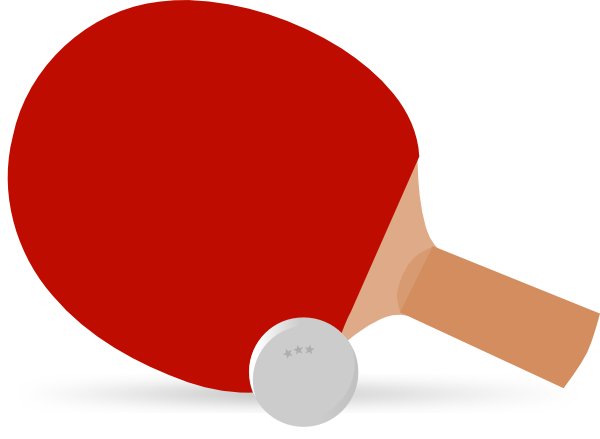
This image has format transparent PNG with resolution 600x439.
You can download this image in best resolution from this page and use it for design and web design.
Ping Pong racket PNG image with transparent background you can download for free, just click on download button.
Table tennis, also known as ping-pong and whiff-whaff, is a sport in which two or four players hit a lightweight ball, also known as the ping-pong ball, back and forth across a table using small rackets. The game takes place on a hard table divided by a net. Except for the initial serve, the rules are generally as follows: players must allow a ball played toward them to bounce one time on their side of the table and must return it so that it bounces on the opposite side at least once. A point is scored when a player fails to return the ball within the rules. Play is fast and demands quick reactions. Spinning the ball alters its trajectory and limits an opponent's options, giving the hitter a great advantage.
Table tennis is governed by the worldwide organization International Table Tennis Federation (ITTF), founded in 1926. ITTF currently includes 226 member associations. The table tennis official rules are specified in the ITTF handbook. Table tennis has been an Olympic sport since 1988, with several event categories. From 1988 until 2004, these were men's singles, women's singles, men's doubles and women's doubles. Since 2008, a team event has been played instead of the doubles.
The international rules specify that the game is played with a sphere having a mass of 2.7 grams (0.095 oz) and a diameter of 40 millimetres (1.57 in).[24] The rules say that the ball shall bounce up 24–26 cm (9.4–10.2 in) when dropped from a height of 30.5 cm (12.0 in) onto a standard steel block thereby having a coefficient of restitution of 0.89 to 0.92. Balls are now made of a polymer instead of celluloid as of 2015, colored white or orange, with a matte finish. The choice of ball color is made according to the table color and its surroundings. For example, a white ball is easier to see on a green or blue table than it is on a grey table. Manufacturers often indicate the quality of the ball with a star rating system, usually from one to three, three being the highest grade. As this system is not standard across manufacturers, the only way a ball may be used in official competition is upon ITTF approval (the ITTF approval can be seen printed on the ball).
The 40 mm ball was introduced after the end of the 2000 Summer Olympics; previously a 38 mm ball was standard. This created some controversies. Then World No 1 table tennis professional Vladimir Samsonov threatened to pull out of the World Cup, which was scheduled to debut the new regulation ball on October 12, 2000.
The table is 2.74 m (9.0 ft) long, 1.525 m (5.0 ft) wide, and 76 cm (2.5 ft) high with any continuous material so long as the table yields a uniform bounce of about 23 cm (9.1 in) when a standard ball is dropped onto it from a height of 30 cm (11.8 in), or about 77%. The table or playing surface is uniformly dark coloured and matte, divided into two halves by a net at 15.25 cm (6.0 in) in height. The ITTF approves only wooden tables or their derivates. Concrete tables with a steel net or a solid concrete partition are sometimes available in outside public spaces, such as parks.
Players are equipped with a laminated wooden racket covered with rubber on one or two sides depending on the grip of the player. The ITTF uses the term "racket", though "bat" is common in Britain, and "paddle" in the U.S. and Canada.
The wooden portion of the racket, often referred to as the "blade", commonly features anywhere between one and seven plies of wood, though cork, glass fiber, carbon fiber, aluminum fiber, and Kevlar are sometimes used. According to the ITTF regulations, at least 85% of the blade by thickness shall be of natural wood. Common wood types include balsa, limba, and cypress or "hinoki", which is popular in Japan. The average size of the blade is about 17 centimetres (6.7 in) long and 15 centimetres (5.9 in) wide, although the official restrictions only focus on the flatness and rigidity of the blade itself, these dimensions are optimal for most play styles.
Table tennis regulations allow different rubber surfaces on each side of the racket. Various types of surfaces provide various levels of spin or speed, and in some cases they nullify spin. For example, a player may have a rubber that provides much spin on one side of their racket, and one that provides no spin on the other. By flipping the racket in play, different types of returns are possible. To help a player distinguish between the rubber used by his opposing player, international rules specify that one side must be red while the other side must be black. The player has the right to inspect their opponent's racket before a match to see the type of rubber used and what colour it is. Despite high-speed play and rapid exchanges, a player can see clearly what side of the racket was used to hit the ball. Current rules state that, unless damaged in play, the racket cannot be exchanged for another racket at any time during a match.
In this clipart you can download free PNG images: Ping Pong PNG images free download, ping pong ball PNG, Ping pong racket